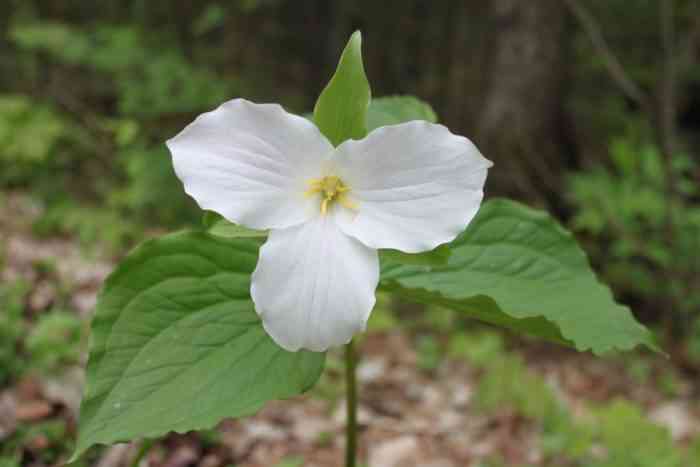White Trillium, an Official Emblem.
Photo:
David M. Chambers via Unsplash
The white trillium (Trillium grandiflorum), also known as the wake-robin and the white lily, was officially adopted as Ontario’s floral emblem in 1937. These perennial wildflowers are ideal for shade gardens and wooded wildflower gardens.
The Eastern North America piedmont and mountains are home to the perennial wildflower known as the white trillium. In nature, you can find it on hills above “rich” rock types, mesic slopes, and rich cove forests. Rhizomes help it slowly spread.
Quick Growing Guide
Botanical Name: Trillium grandiflorum
En français: Trille blanc, trille à grande fleur
Colour:
Blooms:
Sun / Shade:
Watering:
Water: Medium to moist
Height:
Pollinators:
In nature, 2-4 inch flowers are held above broad, glossy, and green bracts, making them some of the biggest and showiest trillium flowers. Plant on humus-rich, well-drained soils with partial to complete shade. They look fantastic when mass-planted in wooded areas.
Read about Purple Trillium, a sister plant, in the same botanical family.
Appearance
Trilliums bloom early and become dormant by midsummer, yet with suitable growing conditions they are easy to care for and long-lived in the garden. In order for them to thrive in the home garden, you must mimic their native habitat by providing moist, well-draining soil enriched with organic matter.
White Trillium is a spring ephemeral that is fairly simple to recognize. This medium-sized plant can be identified by its three-petaled white blossom, which rises above a whorl of three leaves. Perennial white trillium grows from a solitary rootstalk. The tiny rhizome that gives rise to this rootstalk has extensive roots.

Planting and Growing White Trillium
Trillium wildflowers require little upkeep once they are established in the garden. You only need to maintain the soil evenly moist but not soggy, provided that they were planted in an appropriate position.
They are difficult to transplant. Since white trillium does not transplant well, you must carefully select the growth location. The planting location should be cool, shady, and free from trees with shallow roots that could compete with it for water. The planting soil must also contain some humus because the plant develops best in humus-rich soils in the wild.
Fall is the ideal time to plant white trillium. Dig a planting hole that is 15 cm deep, neatly arrange and stretch the plant’s roots before placing them in the hole, cover the roots with earth, and lightly push down. To keep the soil’s top moist, it’s a good idea to cover it with organic materials like shredded bark or hay.
Soil
White trillium prefers loose, rich, moist, somewhat acidic, and well-drained soil. The pH range should be between 5.0 and 6.5 and not more than 7.3. By incorporating a modest amount of organic fertilizer, you can improve the soil if it is devoid of life or has poor air permeability.
Planting white trillium in the fall is recommended. The plant’s roots should be carefully arranged and extended before being placed into the planting hole. The dirt should then be applied to the roots, and you should apply light pressure to compact it. In order to keep moisture in the soil, it is a good idea to cover the soil’s surface with organic materials like hay or finely chopped bark.
Water
White trillium seedlings require frequent watering to prevent the soil from drying out. This is essential as the plant gets used to its new surroundings and starts to develop regularly. White trillium doesn’t require much watering after it has adapted. Simply maintain soil moisture and prevent waterlogging.
Fertilizer
Little fertilization is necessary for white trillium. Simply use a modest amount of composted manure after the spring frost season and some organic fertilizers at planting time. To encourage blooming, you can also use a small amount of low-nitrogen fertilizer (with a 5-10-10 NPK ratio). Avoid spraying fertilizer on foliage or flowers.
White Trillium Habitat
Eastern North America’s deciduous woodlands are the typical habitat for white trillium growth. It has been spotted in a few places in the western United States. There are also a few places in Europe and Japan where white trillium grows. Rich soils with some sun and shade are preferred by it. Trilliums also favor dry to slightly humid air.
Uses
You can cook the leaves and eat them. The young shoots may be boiled and eaten as a vegetable. It is best not to eat the fruit, however. The optimum practice is to pick just one leaf for each plant due to the (about) seven-year life cycle. Picking the flower can seriously injure the plant and it can take years to recover.
White Trilliums are Protected in Ontario
Consult your local regulations to see if this plant is protected. Trilliums are forbidden to be plucked in provincial parks or on conservation grounds in the province of Ontario. Picking both the blossom and the leaves could cause the plant to die since it won’t be able to produce enough energy to make it through the winter and into the next spring.
Companion plants for Trillium Grandiflorum
Hepatica, cyclamen, dicentra, epimedium, erythronium, primula, sanguinaria, and Arisaema are suitable companion plants for white trillium. Trilliums grow well alongside spring-flowering bulbs like scilla, chionodoxa, and anemones as well.







Leave a Reply
You must be logged in to post a comment.